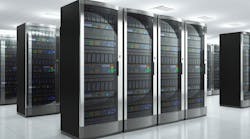6 Key Trends for the Future
by: Mohammed Imran
Data centers, also known as computer centers, include backup power supplies, additional data communications connections, air conditioning and fire suppression systems, and security devices. Data centers house the devices that help in processing company’s business transactions, maintaining financial records, website hosting, and e-mail routing.
Given that heavy responsibility, data center infrastructure must include standby power supplies to operate when commercial electricity fails and additional network stations to handle communication needs if a networking device malfunctions. In addition, they should have sufficient power, data, and cooling throughout the rooms that allow deployment of additional servers per their growth plan.
The data center infrastructure is categorized into 3 segments:
• Storage includes hard disks, solid state drives (SSD) and flash memories.
• Servers includes the tower, rack and blade servers.
• Network equipment includes Ethernet switches, routers, network security equipment, wide area network (WAN) optimization appliances, and storage area network (SAN).
Historical View
Prior to 2007, energy consumption and costs were not the key aspects of organizations IT budgets. Few organizations were not keen to separately meter their data centers, limiting visibility into rising consumption.
From 2007 to 2013, data center managers faced a new major concern of energy efficiency due to the growth in the capacity and density. The top data center infrastructure concerns during that period were heat density, power density, energy efficiency and availability. The rise in the energy prices, increasing energy consumption and environmental concerns put even greater pressure on the data center managers. Thankfully, more efficient power and cooling technologies were quickly introduced and implemented. Apart from this, IT organizations increasingly began to deactivate unproductive servers.
The concept of virtualization broke the linking between physical servers and applications and helped in achieving high management flexibility and high server utilization rates. The concept of virtualization became widely accepted in the industry as many organizations were able to increase server efficiency and reduce overall data center energy consumption.
The key benefits of virtualization include:
- Less heat build-up
- Reduced cost
- Easier backups
- Greener pastures (Greener pastures reduce the excessive power and cooling costs and improves operational proficiency.)
- Better disaster recovery
- Easier migration to the cloud
- Better testing
About that time, the distinction between voice and data centers was also diminishing because virtualization was breaking down the walls between servers. In 2013, the adoption of voice over-IP increased significantly and only 25 percent of businesses were operating analog telecommunications.
Today’s Data Centers and 6 Key Market Trends
Hyperscale facilities (mega facilities) are now being built by Internet-based businesses such as Facebook, software as a service (SaaS), and cloud providers. Hyperscale data centers are transforming the data center business by focusing more on hardware standardization, infrastructure innovation, and modular expansion to help reduce costs, improve efficiency, and ensure scalability of data center operations.
In the past, data center growth was largely driven by processing or computer power. Today, most data center demand is driven by the need to not only store the data but also to access it and to use it. The increasing amount of data and digital intelligent devices of all kinds are expected to drive the data center industry.
The global data center infrastructure market, including servers, storage, network equipment, security, and virtualization, is expected to reach around $150 billion by the end of 2016. On the consumer side, everything from social networking platforms to online banking services require strong infrastructure.
Hence, it is evident that in the Asia-Pacific (APAC) region, huge infrastructure investments are occurring to provide online services to customers especially in the key markets such as China and India. Due to the size of the population in these nations, the market has huge potential demand for data center infrastructure.
In terms of data center growth, APAC is the fastest growing region, whereas, North America will remain the largest market (around 40 percent of global market) for data center infrastructure by value.
Globally, there will be an increased focus on Bring Your Own Device (BYOD), big data, Internet of Things, and cloud services.
Some of the key trends to watch for in 2015 are:
Trend #1: Disaster prevention
Key strategies such as business continuity and disaster prevention are expected to gain significant importance in the future. Many organizations have a strong awareness of possible failures both in terms of man-made and natural disasters.
Trend #2: Shift to Internet data centers
In 2015, organizations across the globe will be shifting from captive data centers to Internet data centers (third-party data centers). This is mainly due to the fact that services from Internet data centers require no capital investment, but deliver high operational efficiency and scalable infrastructure.
The increased complexity in IT infrastructure leads to a major challenge for many captive data centers to manage the power and cooling requirements as most of captive data centers operate on old DC equipment. These types of technology upgrades and investments in technology for the future can be concerns in captive data centers. Whereas, third party data centers (Internet data centers) are supplied with the most recent technology upgrades and are managed well.
Trend #3: SDN and virtualization
Over the years, data centers experienced significant changes due to the emergence of software-defined servers (also defined as virtualization), software-defined storage, and software-defined networking. In the software defined world, the physical infrastructure with software consideration is to decouple the computing control with the actual infrastructure so that computing can be brought together on demand from available components. It helps the users in scaling, provisioning, managing, and deconstructing traditional computing systems.
Trend #4: Density and heat
Increasing computing power and speeds is usually measured as density in data centers. There has been a significant increase in data center density over the past decade. This is due to the high memory capacity, processors, and the next generation of gigabit Ethernet (GbE). These things have increased density and heat that must be addressed to increase the performance of these data centers.
Trend #5: Big data
Key business decisions depend on accurate and appropriate data and data centers must rise to that challenge. Analyzing big data has become vital to data centers. In fact, big data, along with computing and storage needs, is expected to drive the network infrastructure and storage hardware in upcoming years.
Trend #6: Internet of things
The biggest disruption to data centers will be the Internet of Things (IoT). The proliferation of sensor devices sending data by cloud and then being analyzed in real time via data analytics is certainly changing the way data centers will be optimized in the future.
The above disruptive trends and emerging technologies are reshaping every inch of the data center. However, going forward, the importance and spending patterns in data centers are expected to increase significantly. We also believe most of the data centers across the globe will be managed by expert data center providers or will be completely outsourced to third party data centers. This will be due to the increasing adoption of outsourcing services by enterprises that allows them to focus more on their core business areas.
About the Author
Mohammed Imran is Senior Research Analyst at Infoholic Research. He has more than 5 years of experience in Research and Analysis at Datamonitor, Williams Lea, and TBR Company. Infoholic Research is a global market research and consulting organization. We provide market intelligence in emerging, niche technologies and markets. Our market analysis powered by rigorous methodology and quality metrics provide information and forecasts across emerging markets, emerging technologies and emerging business models. Our deep focus on industry verticals and country reports helps our clients to identify opportunities and develop business strategies. For more information, email [email protected] or visit www.infoholicresearch.com.




